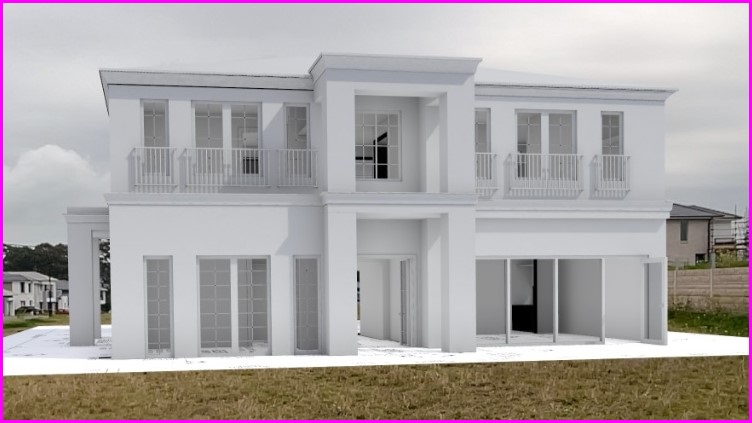Designing your dream home?
Sydney luxury home builder Hall & Hart has a new way of looking at your creation – a pair of virtual reality (VR) goggles.
Put them on, and you’ll instantly be looking at a photorealistic rendering of the front door of your new house, which you can open, walk through, and look around to your heart’s content.
Open cabinets. Look through windows. Check out the view while lying on the bed in your master suite. Bend over and look inside the cupboards.
One client ‘climbed into’ the bathtub of his future home and decided to change the position of the bathroom windows to improve his bathtime views.
Another realised that a separate living area was cramping the open plan part of the house – allowing the builder’s team to remove the separate area and adjust the design accordingly, long before any holes had been dug.
Over the past 18 months, VR is now used in every home the bespoke luxury builder creates – with designs progressing from hand-drawn sketches to digital elevations and plans built in CAD systems, to 3D models that are fed into the Enviz platform for conversion to an interactive version.
Clients are then given a pair of goggles, a link to access the virtual home design, and a checklist of elements to explore as they go home to ‘walk’ through the design and discuss changes with friends and family before sending feedback to the designers.
“A lot of people struggle trying to visualise from a 2D drawing,” Hall & Hart general manager Craig Sutton told Information Age, “and even those that can visualise from a 3D drawing still aren’t good at estimating turning space, sizing, and things like that – and that’s where the VR really kicks in, because you get spatial awareness that just adds that extra layer.”
Once the client is happy with the design, the team progresses to engineering, interior design and documentation stages using the virtual model – completing a feedback loop that, Sutton said, provides “very significant benefits in terms of our own design process and customer satisfaction.”
Virtual design “saves us from making costly adjustments later in the build,” he said.
“Time is money, and being able to make updates quickly and identify challenges early has been a game-changer for our business and our clients.”

You can change the placement of windows before a single brick is laid. Photo: Supplied
Turning virtual reality into, well, reality
Trying to convey the scale, complexity and emotional resonance of real estate has kept architects, builders, and real estate agents exploring new technologies including detailed raytraced renderings – which can simulate sunlight and shadows at any time of day – and the panning 360-degree views that became a lifeline for buyers when pandemic lockdowns drove real estate sales online.
Those technologies are not as immersive and effective as VR walkthroughs, notes Michael Shaw, CEO of Australian firm Enviz, which has parlayed pandemic-driven technological innovation into an immersive virtual walkthrough tool now used by high-end home and apartment builders in New York, London, Miami, and Panama.
The use of augmented reality (AR) and VR – both part of the broader ‘extended reality’ vision – enables users “to walk around the space at a 1:1 scale,” Shaw told Information Age.
“We’re trying to recreate the open home experience, but for a house that doesn’t exist.”
Clients can also virtually explore properties using the motion sensors built into smartphones and tablets, although Shaw said VR goggles – which are calibrated to simulate the exact view from the height of your eyes – deliver “by far the most immersive experience.”
Although Hall & Hart sends its clients a Meta Quest 2 VR headset, Shaw said Apple’s “next level” Vision Pro headset is setting the pace in a market that has taken time to find the right balance of technology, usability, and practicality.
“Even though companies like Meta, Apple, Microsoft, and Google have been investing billions, it’s only now that the devices are actually getting to that point where they’re light enough, the quality is good enough, the battery life is long enough, and the price point is there.”
Changing one industry at a time
Whether a good product can kick-start the market singlehandedly, however, is up in the air: VR goggles have struggled to break into other markets, with research firm IDC recently confirming they are a popular holiday purchase but that sales drop off a cliff after New Year’s.
IDC sees the market at a tipping point, forecasting a return to growth this year even as Apple – which has struggled to boost lackluster sales of its $6000 Vision Pro goggles – contemplates a less expensive version as it tweaks its strategy for what it has positioned as a personal productivity tool.
It’s a chicken-and-egg issue, since prices won’t come down until demand increases – but increasing demand will depend on finding use cases other than gaming.
Companies like Siemens and Onirix are pursuing opportunities in the industrial metaverse, an XR driven paradigm in which staff train and work using ‘digital twins’ of industrial machines (and entire cities) that work – and break – in the same way as the real ones.
Analyst firm GlobalData recently noted a surge in demand for industrial metaverse roles, with major companies actively hiring VR/AR solution architects, metaverse technology strategists and senior digital solutions engineers as the concept gains traction.
Sutton, for his part, sees virtual walkthroughs as part of a construction industry transformation that will see builders, developers, and trades collaborating on digital twins – allowing them to quickly assemble and, using VR goggles, visually troubleshoot elements such as the structure of steel beams or the positioning of heating ducts and plumbing.
“It’s an industry issue and we’re slowly getting there,” he said, noting that some suppliers already have advanced building information modelling (BIM) capabilities while others are still in early days.
“That’s definitely something we’d like to do one day.”










